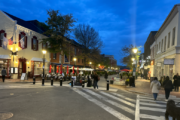POTSDAM, Germany (AP) — The avenues, monuments and gardens in the park surrounding Sanssouci Palace, a sprawling green oasis in the heart of the German city of Potsdam and a UNESCO world heritage site, look as magnificent as ever.
But a closer look shows that all is not well with the park’s trees, which increasingly are struggling with the effects of climate change. Among the signs are beech trees with thinning crowns, big branches that have crashed to the ground and trunks with much of their bark peeled off.
“I’ve been watching this garden for over 30 years, and I see very serious changes,” says Sven Kerschek, a former chief gardener for part of the park. “Since 2017 or 2018, we have had a very, very serious increase in trees and shrubs dying; and not just dying, the health of the trees is changing.”
The region experienced a particularly hot and dry summer in 2018, followed by several more years with little rain. Comparatively wet summers last year and this year haven’t made up for their effects.
Heat and a lack of rain aren’t the only problems, Kerschek says: “Climate change is more complex.” Well-watered trees standing on the banks of streams and lakes also show signs of stress. Constant harsh sunlight, a lack of atmospheric humidity, storms, increasing fungal infections and the spread of insect species that didn’t previously occur in the area are among other factors that play a part.
From 2002 until 2015, the park lost between 18 and 87 trees every year. The number hasn’t dropped below 100 since; it reached 315 in 2020 before falling back somewhat.
The Prussian Palaces and Gardens Foundation, which oversees Sanssouci Park and many other sites in Berlin and the surrounding state of Brandenburg, is telling the story of the trees’ struggle with climate change in an open-air exhibition this summer, titled “Re:Generation.” At points around the park, visitors can see examples of the problems and ideas for how they might be tackled.
“Perhaps the exhibition will help point out that we have such problems here; that extreme examples of climate change are already visible not just where people live in a river valleys and have to experience a flood, but also in idyllic Sanssouci Park,” says Katrin Schröder, a curator of gardens at the foundation.
Visitors are pointed to trees suffering from “sunburn,” with drying and peeling bark making them vulnerable to fungi and animals. They can see that ground water receded drastically at times in recent years, making life difficult for older trees in particular. But there are also more heartening examples, “survival artists” that have defied the difficulties.
Those trees give the gardeners reason to hope. Kerschek, who helped design the exhibition, says they want to “try to continue working with the genetic material we have here in the garden.”
The oldest trees in Sanssouci Park are about 300 years old. The hope is that robust older trees which have already been through variations in climate are better placed to adapt — and that even if they don’t look particularly healthy themselves, they can pass on that capability in their seeds. One idea is to collect those seeds and grow young trees in a special nursery mirroring the difficult conditions of the park, Kerschek says.
Sanssouci Palace itself was the summer residence of Prussian King Frederick II, better known as Frederick the Great. It was completed in 1747 with opulent vineyard terraces, a royal retreat with a name that translates from French as “carefree.”
The garden was later expanded substantially, growing into a 19th-century landscaped park that covers nearly 300 hectares (740 acres) and measures more than 2 kilometers (1 1/4 miles) from east to west. It has nearly 60 gardeners and has been part of UNESCO’s World Heritage List since 1990.
While almost all the native tree species in the park have struggled with the effects of climate change, the solution is not to move to exotic species.
Schröder notes that Potsdam still has a central European climate with sometimes long and very late frosts, so “we can’t do anything here with Mediterranean vegetation.”
But one approach may be to look at whether it could use varieties of linden trees, oaks, beeches or others from areas such as southeastern Europe that have very hot summers but also late frosts, she says — on condition that they look similar to the trees already at Sanssouci.
“We don’t want to change the park in such a way that it it has a completely changed mixture of trees,” Schröder says.
___
AP video journalist Pietro De Cristofaro contributed to this report.
Copyright © 2024 The Associated Press. All rights reserved. This material may not be published, broadcast, written or redistributed.







